IKEA Case Study: External and Internal Strategic Analysis
VerifiedAdded on 2021/02/21
|14
|3683
|101
Case Study
AI Summary
This case study analyzes IKEA, a multinational corporation in the retail sector. It begins with an external analysis, examining political, economic, socio-cultural, global, technological, and demographic factors affecting the retail industry. Porter's Five Forces are applied to assess the competitive landscape, highlighting threats and opportunities. The internal analysis evaluates IKEA's resources and capabilities, including supply chain management, market expansion, diversification, and investment capabilities. A core competency analysis identifies diversification as a key strength. The study concludes with an articulation of key issues and recommendations for IKEA's strategic development, emphasizing the implications of the proposed strategies within the dynamic business environment. The analysis provides a comprehensive overview of IKEA's strategic position and future prospects.
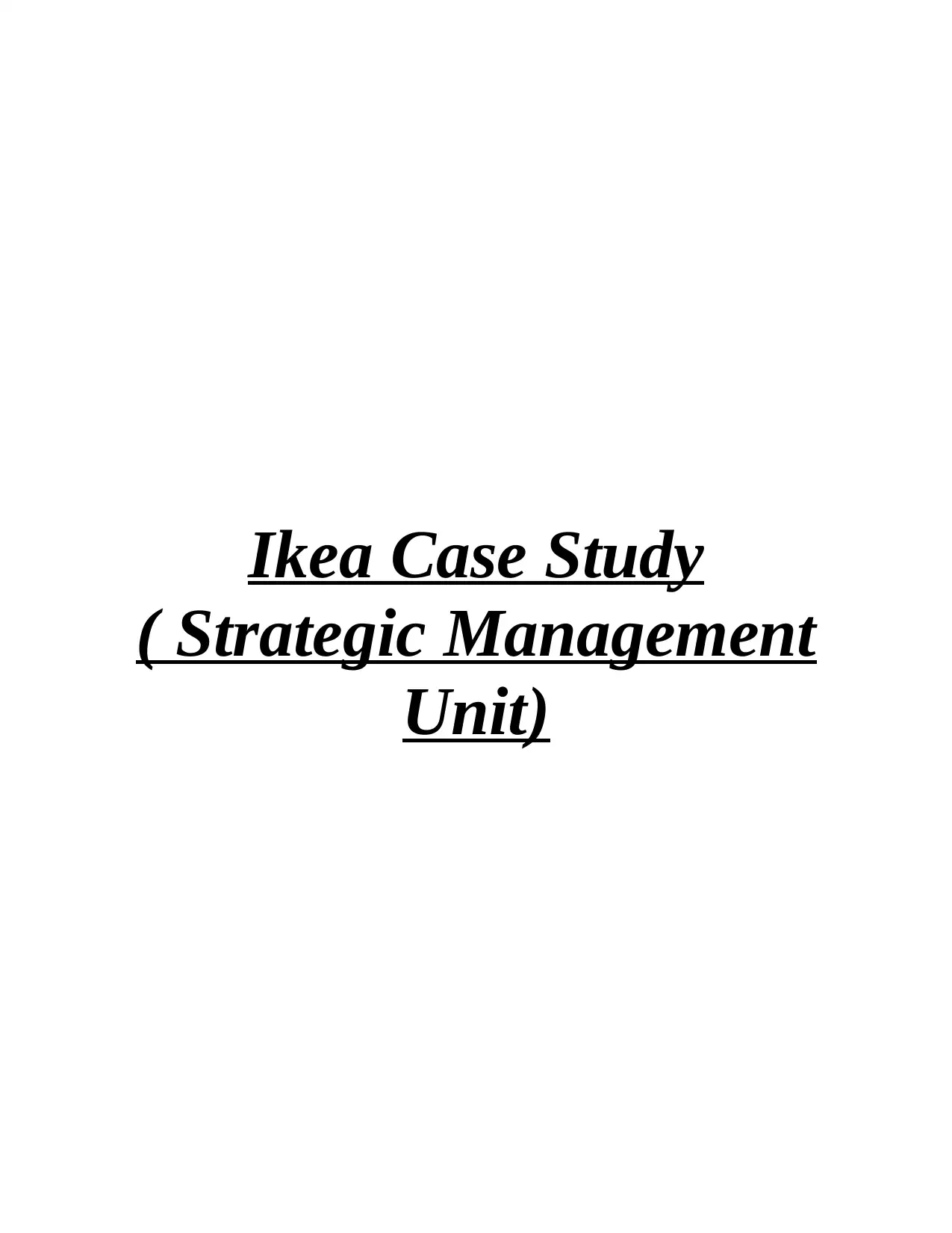
Ikea Case Study
( Strategic Management
Unit)
( Strategic Management
Unit)
Paraphrase This Document
Need a fresh take? Get an instant paraphrase of this document with our AI Paraphraser
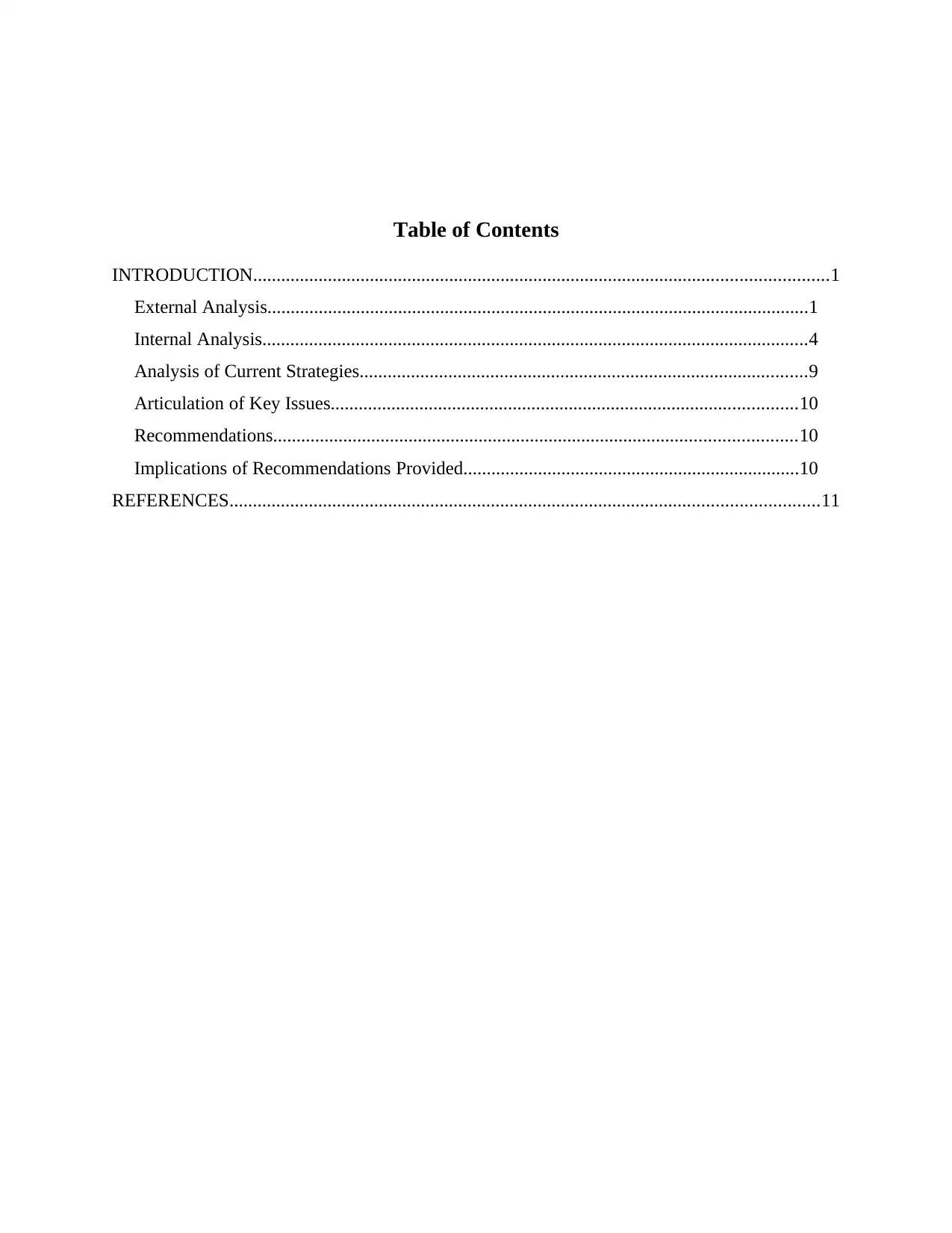
Table of Contents
INTRODUCTION...........................................................................................................................1
External Analysis....................................................................................................................1
Internal Analysis.....................................................................................................................4
Analysis of Current Strategies................................................................................................9
Articulation of Key Issues....................................................................................................10
Recommendations................................................................................................................10
Implications of Recommendations Provided........................................................................10
REFERENCES..............................................................................................................................11
INTRODUCTION...........................................................................................................................1
External Analysis....................................................................................................................1
Internal Analysis.....................................................................................................................4
Analysis of Current Strategies................................................................................................9
Articulation of Key Issues....................................................................................................10
Recommendations................................................................................................................10
Implications of Recommendations Provided........................................................................10
REFERENCES..............................................................................................................................11

⊘ This is a preview!⊘
Do you want full access?
Subscribe today to unlock all pages.

Trusted by 1+ million students worldwide
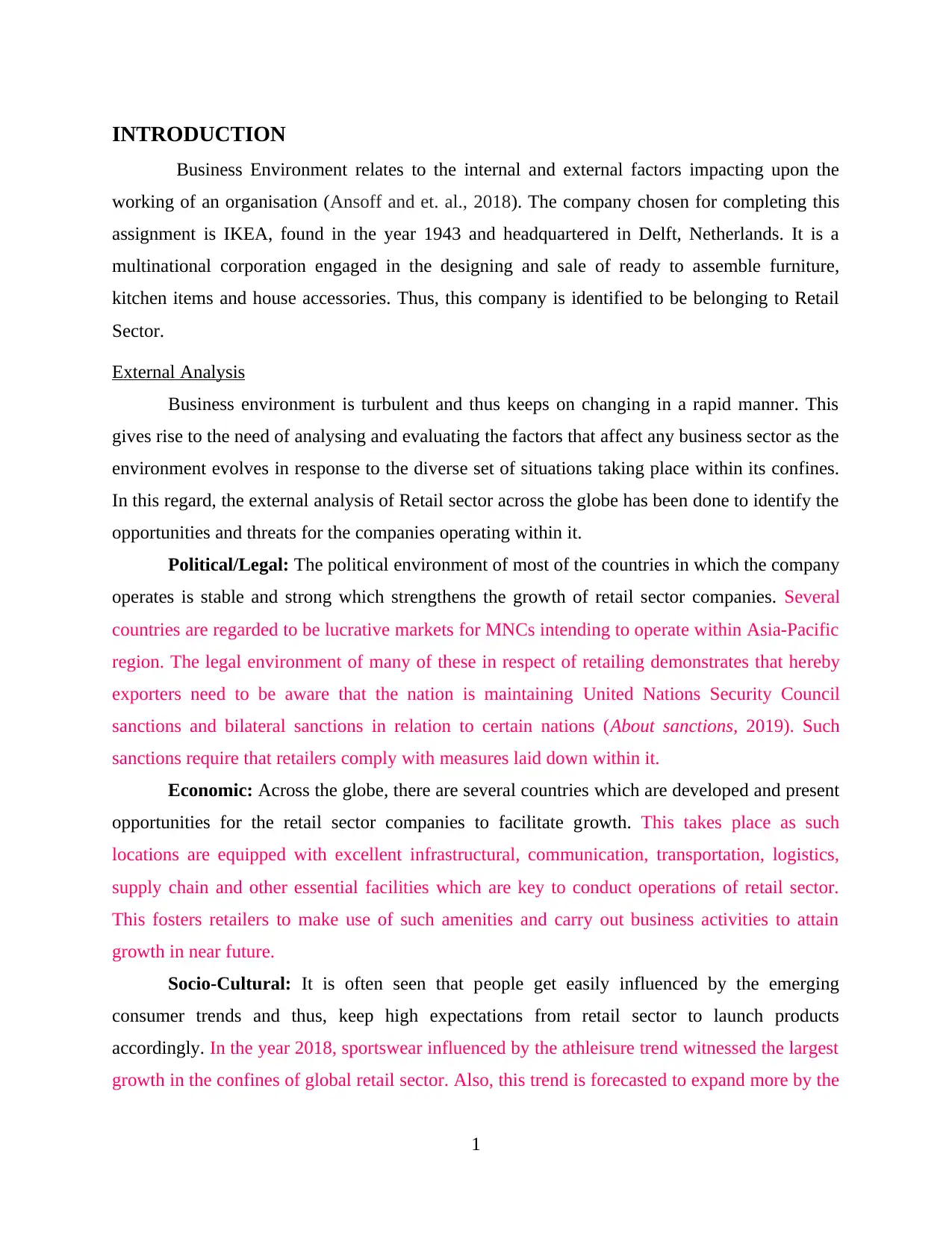
INTRODUCTION
Business Environment relates to the internal and external factors impacting upon the
working of an organisation (Ansoff and et. al., 2018). The company chosen for completing this
assignment is IKEA, found in the year 1943 and headquartered in Delft, Netherlands. It is a
multinational corporation engaged in the designing and sale of ready to assemble furniture,
kitchen items and house accessories. Thus, this company is identified to be belonging to Retail
Sector.
External Analysis
Business environment is turbulent and thus keeps on changing in a rapid manner. This
gives rise to the need of analysing and evaluating the factors that affect any business sector as the
environment evolves in response to the diverse set of situations taking place within its confines.
In this regard, the external analysis of Retail sector across the globe has been done to identify the
opportunities and threats for the companies operating within it.
Political/Legal: The political environment of most of the countries in which the company
operates is stable and strong which strengthens the growth of retail sector companies. Several
countries are regarded to be lucrative markets for MNCs intending to operate within Asia-Pacific
region. The legal environment of many of these in respect of retailing demonstrates that hereby
exporters need to be aware that the nation is maintaining United Nations Security Council
sanctions and bilateral sanctions in relation to certain nations (About sanctions, 2019). Such
sanctions require that retailers comply with measures laid down within it.
Economic: Across the globe, there are several countries which are developed and present
opportunities for the retail sector companies to facilitate growth. This takes place as such
locations are equipped with excellent infrastructural, communication, transportation, logistics,
supply chain and other essential facilities which are key to conduct operations of retail sector.
This fosters retailers to make use of such amenities and carry out business activities to attain
growth in near future.
Socio-Cultural: It is often seen that people get easily influenced by the emerging
consumer trends and thus, keep high expectations from retail sector to launch products
accordingly. In the year 2018, sportswear influenced by the athleisure trend witnessed the largest
growth in the confines of global retail sector. Also, this trend is forecasted to expand more by the
1
Business Environment relates to the internal and external factors impacting upon the
working of an organisation (Ansoff and et. al., 2018). The company chosen for completing this
assignment is IKEA, found in the year 1943 and headquartered in Delft, Netherlands. It is a
multinational corporation engaged in the designing and sale of ready to assemble furniture,
kitchen items and house accessories. Thus, this company is identified to be belonging to Retail
Sector.
External Analysis
Business environment is turbulent and thus keeps on changing in a rapid manner. This
gives rise to the need of analysing and evaluating the factors that affect any business sector as the
environment evolves in response to the diverse set of situations taking place within its confines.
In this regard, the external analysis of Retail sector across the globe has been done to identify the
opportunities and threats for the companies operating within it.
Political/Legal: The political environment of most of the countries in which the company
operates is stable and strong which strengthens the growth of retail sector companies. Several
countries are regarded to be lucrative markets for MNCs intending to operate within Asia-Pacific
region. The legal environment of many of these in respect of retailing demonstrates that hereby
exporters need to be aware that the nation is maintaining United Nations Security Council
sanctions and bilateral sanctions in relation to certain nations (About sanctions, 2019). Such
sanctions require that retailers comply with measures laid down within it.
Economic: Across the globe, there are several countries which are developed and present
opportunities for the retail sector companies to facilitate growth. This takes place as such
locations are equipped with excellent infrastructural, communication, transportation, logistics,
supply chain and other essential facilities which are key to conduct operations of retail sector.
This fosters retailers to make use of such amenities and carry out business activities to attain
growth in near future.
Socio-Cultural: It is often seen that people get easily influenced by the emerging
consumer trends and thus, keep high expectations from retail sector to launch products
accordingly. In the year 2018, sportswear influenced by the athleisure trend witnessed the largest
growth in the confines of global retail sector. Also, this trend is forecasted to expand more by the
1
Paraphrase This Document
Need a fresh take? Get an instant paraphrase of this document with our AI Paraphraser
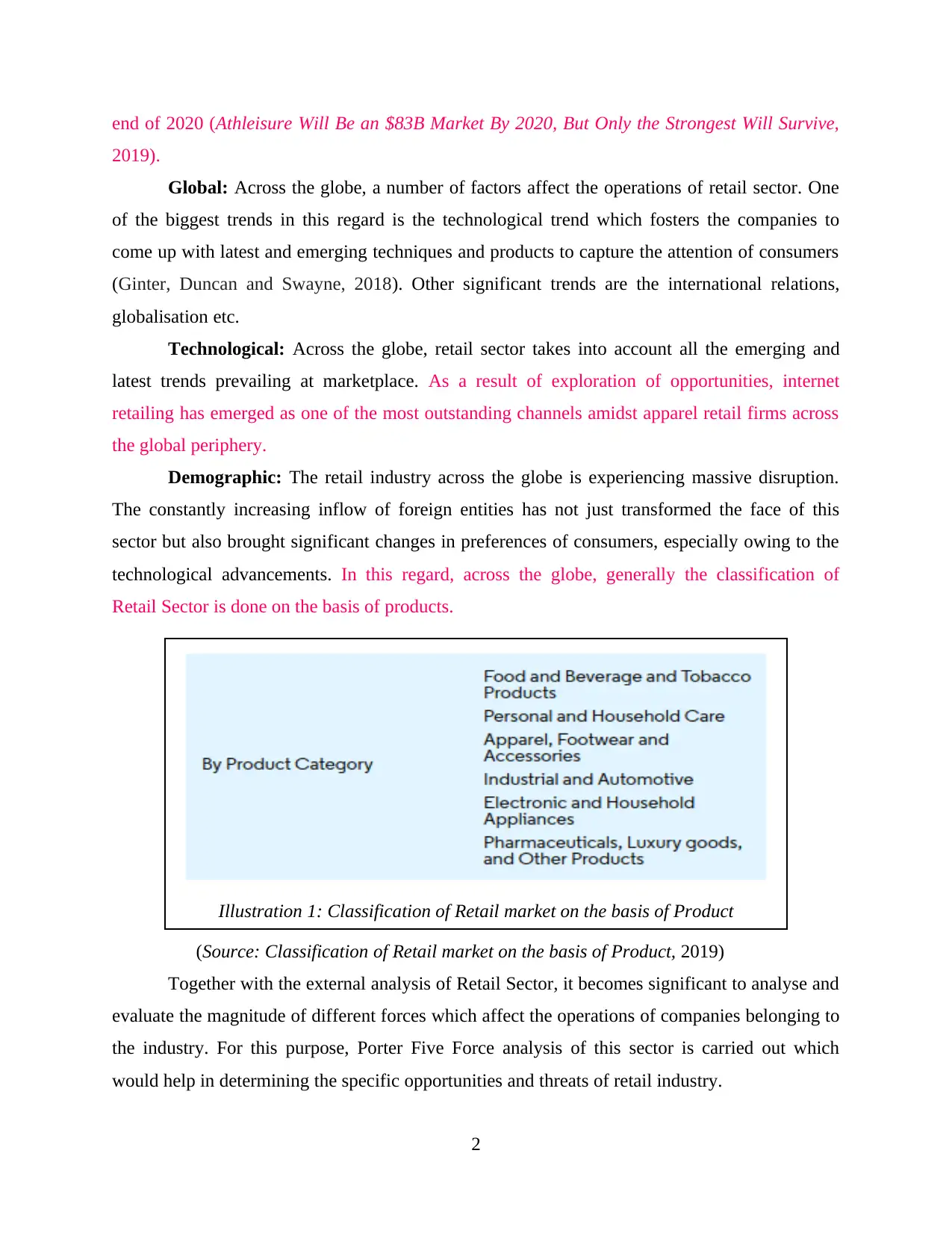
end of 2020 (Athleisure Will Be an $83B Market By 2020, But Only the Strongest Will Survive,
2019).
Global: Across the globe, a number of factors affect the operations of retail sector. One
of the biggest trends in this regard is the technological trend which fosters the companies to
come up with latest and emerging techniques and products to capture the attention of consumers
(Ginter, Duncan and Swayne, 2018). Other significant trends are the international relations,
globalisation etc.
Technological: Across the globe, retail sector takes into account all the emerging and
latest trends prevailing at marketplace. As a result of exploration of opportunities, internet
retailing has emerged as one of the most outstanding channels amidst apparel retail firms across
the global periphery.
Demographic: The retail industry across the globe is experiencing massive disruption.
The constantly increasing inflow of foreign entities has not just transformed the face of this
sector but also brought significant changes in preferences of consumers, especially owing to the
technological advancements. In this regard, across the globe, generally the classification of
Retail Sector is done on the basis of products.
(Source: Classification of Retail market on the basis of Product, 2019)
Together with the external analysis of Retail Sector, it becomes significant to analyse and
evaluate the magnitude of different forces which affect the operations of companies belonging to
the industry. For this purpose, Porter Five Force analysis of this sector is carried out which
would help in determining the specific opportunities and threats of retail industry.
2
Illustration 1: Classification of Retail market on the basis of Product
2019).
Global: Across the globe, a number of factors affect the operations of retail sector. One
of the biggest trends in this regard is the technological trend which fosters the companies to
come up with latest and emerging techniques and products to capture the attention of consumers
(Ginter, Duncan and Swayne, 2018). Other significant trends are the international relations,
globalisation etc.
Technological: Across the globe, retail sector takes into account all the emerging and
latest trends prevailing at marketplace. As a result of exploration of opportunities, internet
retailing has emerged as one of the most outstanding channels amidst apparel retail firms across
the global periphery.
Demographic: The retail industry across the globe is experiencing massive disruption.
The constantly increasing inflow of foreign entities has not just transformed the face of this
sector but also brought significant changes in preferences of consumers, especially owing to the
technological advancements. In this regard, across the globe, generally the classification of
Retail Sector is done on the basis of products.
(Source: Classification of Retail market on the basis of Product, 2019)
Together with the external analysis of Retail Sector, it becomes significant to analyse and
evaluate the magnitude of different forces which affect the operations of companies belonging to
the industry. For this purpose, Porter Five Force analysis of this sector is carried out which
would help in determining the specific opportunities and threats of retail industry.
2
Illustration 1: Classification of Retail market on the basis of Product
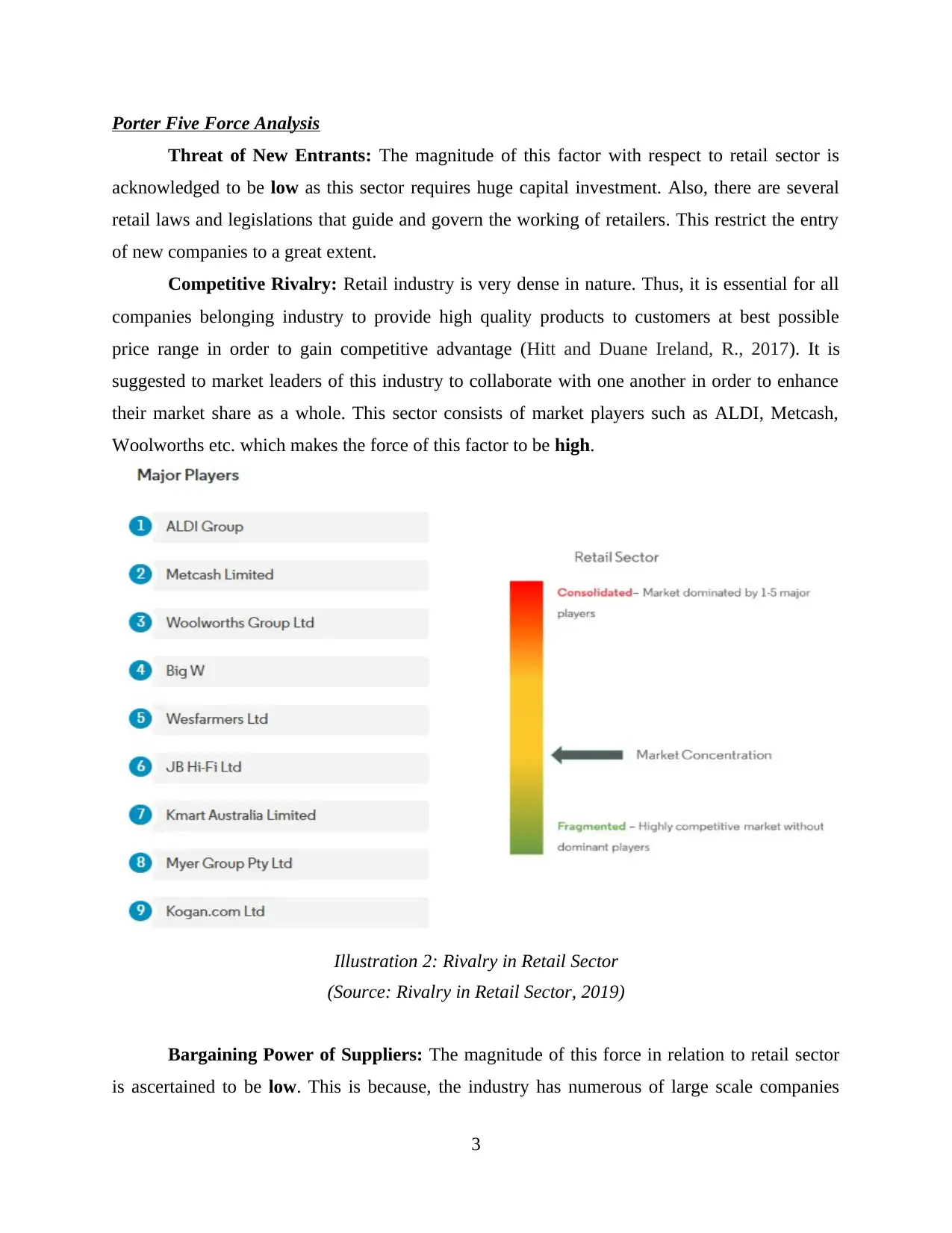
Porter Five Force Analysis
Threat of New Entrants: The magnitude of this factor with respect to retail sector is
acknowledged to be low as this sector requires huge capital investment. Also, there are several
retail laws and legislations that guide and govern the working of retailers. This restrict the entry
of new companies to a great extent.
Competitive Rivalry: Retail industry is very dense in nature. Thus, it is essential for all
companies belonging industry to provide high quality products to customers at best possible
price range in order to gain competitive advantage (Hitt and Duane Ireland, R., 2017). It is
suggested to market leaders of this industry to collaborate with one another in order to enhance
their market share as a whole. This sector consists of market players such as ALDI, Metcash,
Woolworths etc. which makes the force of this factor to be high.
Illustration 2: Rivalry in Retail Sector
(Source: Rivalry in Retail Sector, 2019)
Bargaining Power of Suppliers: The magnitude of this force in relation to retail sector
is ascertained to be low. This is because, the industry has numerous of large scale companies
3
Threat of New Entrants: The magnitude of this factor with respect to retail sector is
acknowledged to be low as this sector requires huge capital investment. Also, there are several
retail laws and legislations that guide and govern the working of retailers. This restrict the entry
of new companies to a great extent.
Competitive Rivalry: Retail industry is very dense in nature. Thus, it is essential for all
companies belonging industry to provide high quality products to customers at best possible
price range in order to gain competitive advantage (Hitt and Duane Ireland, R., 2017). It is
suggested to market leaders of this industry to collaborate with one another in order to enhance
their market share as a whole. This sector consists of market players such as ALDI, Metcash,
Woolworths etc. which makes the force of this factor to be high.
Illustration 2: Rivalry in Retail Sector
(Source: Rivalry in Retail Sector, 2019)
Bargaining Power of Suppliers: The magnitude of this force in relation to retail sector
is ascertained to be low. This is because, the industry has numerous of large scale companies
3
⊘ This is a preview!⊘
Do you want full access?
Subscribe today to unlock all pages.

Trusted by 1+ million students worldwide

who provides order for their expected raw materials to customers in bulk (Meyer, Neck and
Meeks, 2017). This shows that supplier have to agree upon the quotations given by the market
leader of this industry as if they does not agree to the same then there are high chances that they
might switch to another supplier. This will impact upon business of supplier as a result these
suppliers do not have power to influence retail industry towards them which shows their low
power.
Bargaining Power of Buyers: Bargaining power of buyer is high in retail industry. It is
because, there are numerous of companies belonging to this industry are offering similar kind of
product at almost similar price range. This enhances options for buyers as they can switch to any
company belonging to retail industry according to their feasibility (Morden, 2016). Thus, in
order to overcome this, Businesses are expected to introduce products with additional feature in
the same price option for grabbing attention of customers towards their company.
Threat of Substitutes: This power for retail industry is high as businesses are
continuously focusing on introducing alternative products. In order to deal with this situation, it
is essential for retail industry to bring maximum possible innovations in their existing products
or develop new products for customers so that they will get a reason to remain attached with the
same company.
On the basis of above discussion, it can be said that retail sector is attractive and presents
a number of opportunities for the companies operating within its confines. In this regard, it can
be said that the threat of substitutes (high), bargaining power of buyers (high) present threat
while bargaining power of suppliers (low), competitive rivalry (high), threat of new entrants
(low) hold opportunities for retail firms.
Internal Analysis
Analysis of Resources and Capabilities
IKEA is a well renowned organisation operating in a number of countries across the
globe by making use of its resources and capabilities.
Resources:
Being an established retail firm, it has a number of resources which are classified into 2
categories, namely, tangible and intangible.
RESOURCE IMPACT OF THE RESOURCE
4
Meeks, 2017). This shows that supplier have to agree upon the quotations given by the market
leader of this industry as if they does not agree to the same then there are high chances that they
might switch to another supplier. This will impact upon business of supplier as a result these
suppliers do not have power to influence retail industry towards them which shows their low
power.
Bargaining Power of Buyers: Bargaining power of buyer is high in retail industry. It is
because, there are numerous of companies belonging to this industry are offering similar kind of
product at almost similar price range. This enhances options for buyers as they can switch to any
company belonging to retail industry according to their feasibility (Morden, 2016). Thus, in
order to overcome this, Businesses are expected to introduce products with additional feature in
the same price option for grabbing attention of customers towards their company.
Threat of Substitutes: This power for retail industry is high as businesses are
continuously focusing on introducing alternative products. In order to deal with this situation, it
is essential for retail industry to bring maximum possible innovations in their existing products
or develop new products for customers so that they will get a reason to remain attached with the
same company.
On the basis of above discussion, it can be said that retail sector is attractive and presents
a number of opportunities for the companies operating within its confines. In this regard, it can
be said that the threat of substitutes (high), bargaining power of buyers (high) present threat
while bargaining power of suppliers (low), competitive rivalry (high), threat of new entrants
(low) hold opportunities for retail firms.
Internal Analysis
Analysis of Resources and Capabilities
IKEA is a well renowned organisation operating in a number of countries across the
globe by making use of its resources and capabilities.
Resources:
Being an established retail firm, it has a number of resources which are classified into 2
categories, namely, tangible and intangible.
RESOURCE IMPACT OF THE RESOURCE
4
Paraphrase This Document
Need a fresh take? Get an instant paraphrase of this document with our AI Paraphraser
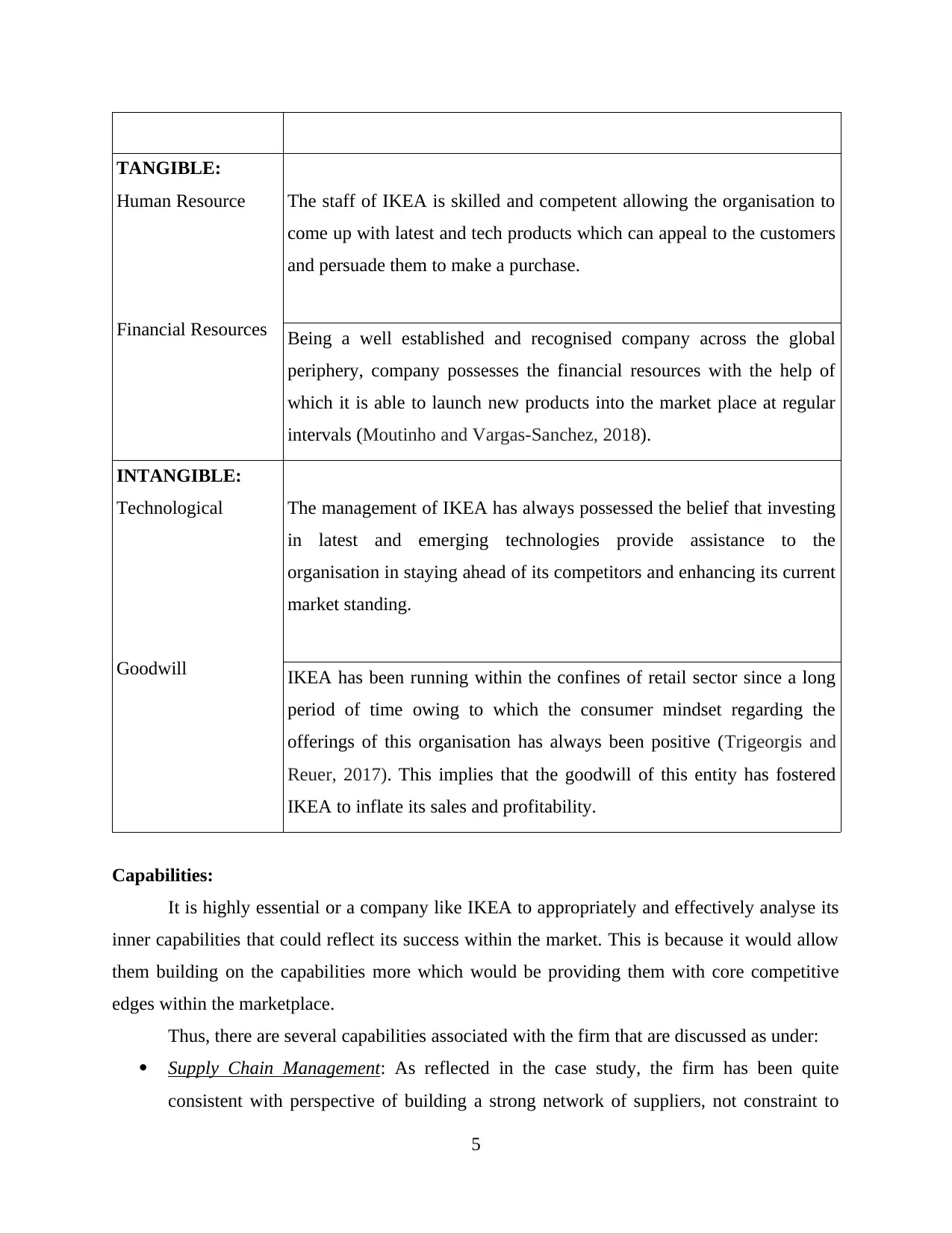
TANGIBLE:
Human Resource
Financial Resources
The staff of IKEA is skilled and competent allowing the organisation to
come up with latest and tech products which can appeal to the customers
and persuade them to make a purchase.
Being a well established and recognised company across the global
periphery, company possesses the financial resources with the help of
which it is able to launch new products into the market place at regular
intervals (Moutinho and Vargas-Sanchez, 2018).
INTANGIBLE:
Technological
Goodwill
The management of IKEA has always possessed the belief that investing
in latest and emerging technologies provide assistance to the
organisation in staying ahead of its competitors and enhancing its current
market standing.
IKEA has been running within the confines of retail sector since a long
period of time owing to which the consumer mindset regarding the
offerings of this organisation has always been positive (Trigeorgis and
Reuer, 2017). This implies that the goodwill of this entity has fostered
IKEA to inflate its sales and profitability.
Capabilities:
It is highly essential or a company like IKEA to appropriately and effectively analyse its
inner capabilities that could reflect its success within the market. This is because it would allow
them building on the capabilities more which would be providing them with core competitive
edges within the marketplace.
Thus, there are several capabilities associated with the firm that are discussed as under:
Supply Chain Management: As reflected in the case study, the firm has been quite
consistent with perspective of building a strong network of suppliers, not constraint to
5
Human Resource
Financial Resources
The staff of IKEA is skilled and competent allowing the organisation to
come up with latest and tech products which can appeal to the customers
and persuade them to make a purchase.
Being a well established and recognised company across the global
periphery, company possesses the financial resources with the help of
which it is able to launch new products into the market place at regular
intervals (Moutinho and Vargas-Sanchez, 2018).
INTANGIBLE:
Technological
Goodwill
The management of IKEA has always possessed the belief that investing
in latest and emerging technologies provide assistance to the
organisation in staying ahead of its competitors and enhancing its current
market standing.
IKEA has been running within the confines of retail sector since a long
period of time owing to which the consumer mindset regarding the
offerings of this organisation has always been positive (Trigeorgis and
Reuer, 2017). This implies that the goodwill of this entity has fostered
IKEA to inflate its sales and profitability.
Capabilities:
It is highly essential or a company like IKEA to appropriately and effectively analyse its
inner capabilities that could reflect its success within the market. This is because it would allow
them building on the capabilities more which would be providing them with core competitive
edges within the marketplace.
Thus, there are several capabilities associated with the firm that are discussed as under:
Supply Chain Management: As reflected in the case study, the firm has been quite
consistent with perspective of building a strong network of suppliers, not constraint to
5
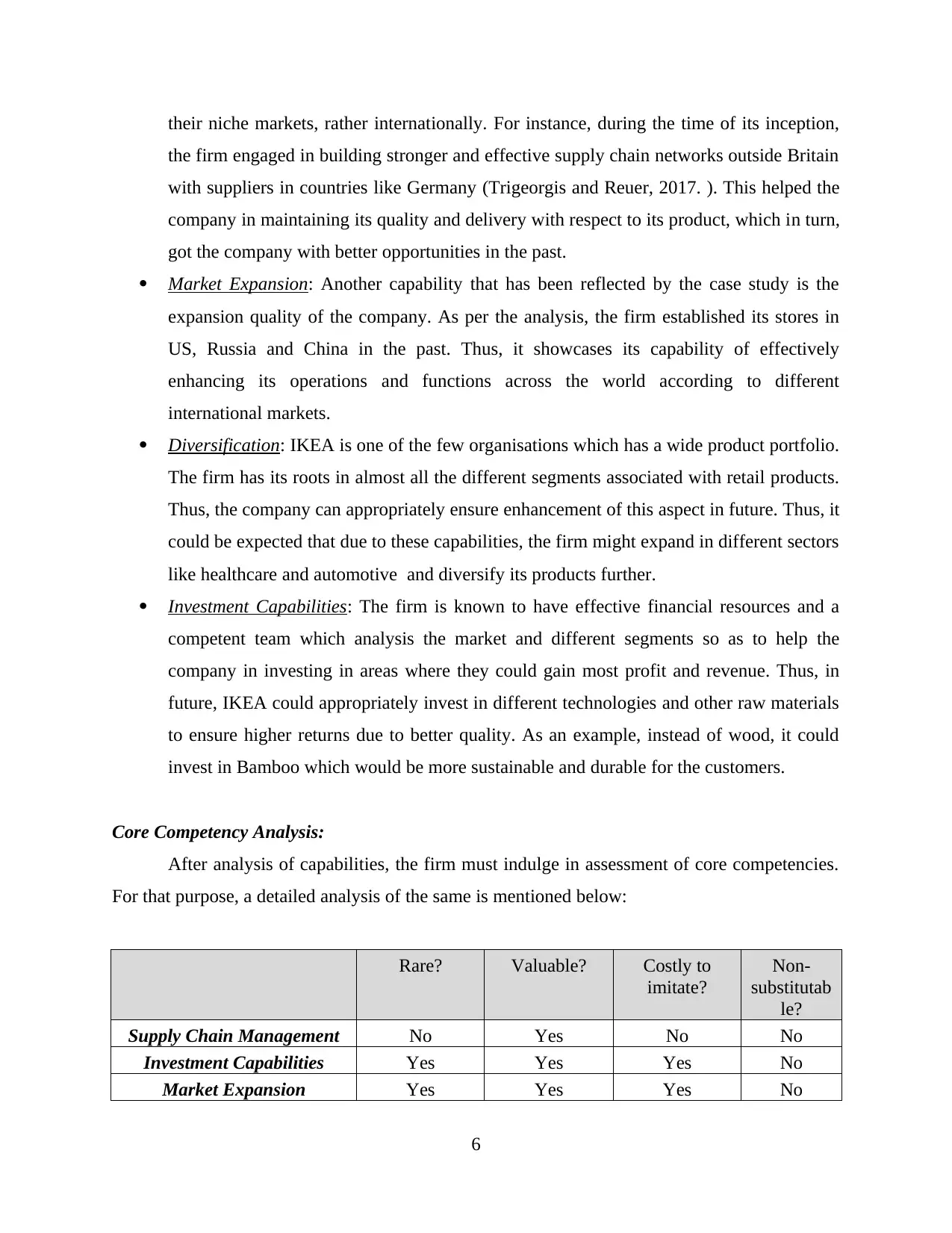
their niche markets, rather internationally. For instance, during the time of its inception,
the firm engaged in building stronger and effective supply chain networks outside Britain
with suppliers in countries like Germany (Trigeorgis and Reuer, 2017. ). This helped the
company in maintaining its quality and delivery with respect to its product, which in turn,
got the company with better opportunities in the past.
Market Expansion: Another capability that has been reflected by the case study is the
expansion quality of the company. As per the analysis, the firm established its stores in
US, Russia and China in the past. Thus, it showcases its capability of effectively
enhancing its operations and functions across the world according to different
international markets.
Diversification: IKEA is one of the few organisations which has a wide product portfolio.
The firm has its roots in almost all the different segments associated with retail products.
Thus, the company can appropriately ensure enhancement of this aspect in future. Thus, it
could be expected that due to these capabilities, the firm might expand in different sectors
like healthcare and automotive and diversify its products further.
Investment Capabilities: The firm is known to have effective financial resources and a
competent team which analysis the market and different segments so as to help the
company in investing in areas where they could gain most profit and revenue. Thus, in
future, IKEA could appropriately invest in different technologies and other raw materials
to ensure higher returns due to better quality. As an example, instead of wood, it could
invest in Bamboo which would be more sustainable and durable for the customers.
Core Competency Analysis:
After analysis of capabilities, the firm must indulge in assessment of core competencies.
For that purpose, a detailed analysis of the same is mentioned below:
Rare? Valuable? Costly to
imitate?
Non-
substitutab
le?
Supply Chain Management No Yes No No
Investment Capabilities Yes Yes Yes No
Market Expansion Yes Yes Yes No
6
the firm engaged in building stronger and effective supply chain networks outside Britain
with suppliers in countries like Germany (Trigeorgis and Reuer, 2017. ). This helped the
company in maintaining its quality and delivery with respect to its product, which in turn,
got the company with better opportunities in the past.
Market Expansion: Another capability that has been reflected by the case study is the
expansion quality of the company. As per the analysis, the firm established its stores in
US, Russia and China in the past. Thus, it showcases its capability of effectively
enhancing its operations and functions across the world according to different
international markets.
Diversification: IKEA is one of the few organisations which has a wide product portfolio.
The firm has its roots in almost all the different segments associated with retail products.
Thus, the company can appropriately ensure enhancement of this aspect in future. Thus, it
could be expected that due to these capabilities, the firm might expand in different sectors
like healthcare and automotive and diversify its products further.
Investment Capabilities: The firm is known to have effective financial resources and a
competent team which analysis the market and different segments so as to help the
company in investing in areas where they could gain most profit and revenue. Thus, in
future, IKEA could appropriately invest in different technologies and other raw materials
to ensure higher returns due to better quality. As an example, instead of wood, it could
invest in Bamboo which would be more sustainable and durable for the customers.
Core Competency Analysis:
After analysis of capabilities, the firm must indulge in assessment of core competencies.
For that purpose, a detailed analysis of the same is mentioned below:
Rare? Valuable? Costly to
imitate?
Non-
substitutab
le?
Supply Chain Management No Yes No No
Investment Capabilities Yes Yes Yes No
Market Expansion Yes Yes Yes No
6
⊘ This is a preview!⊘
Do you want full access?
Subscribe today to unlock all pages.

Trusted by 1+ million students worldwide
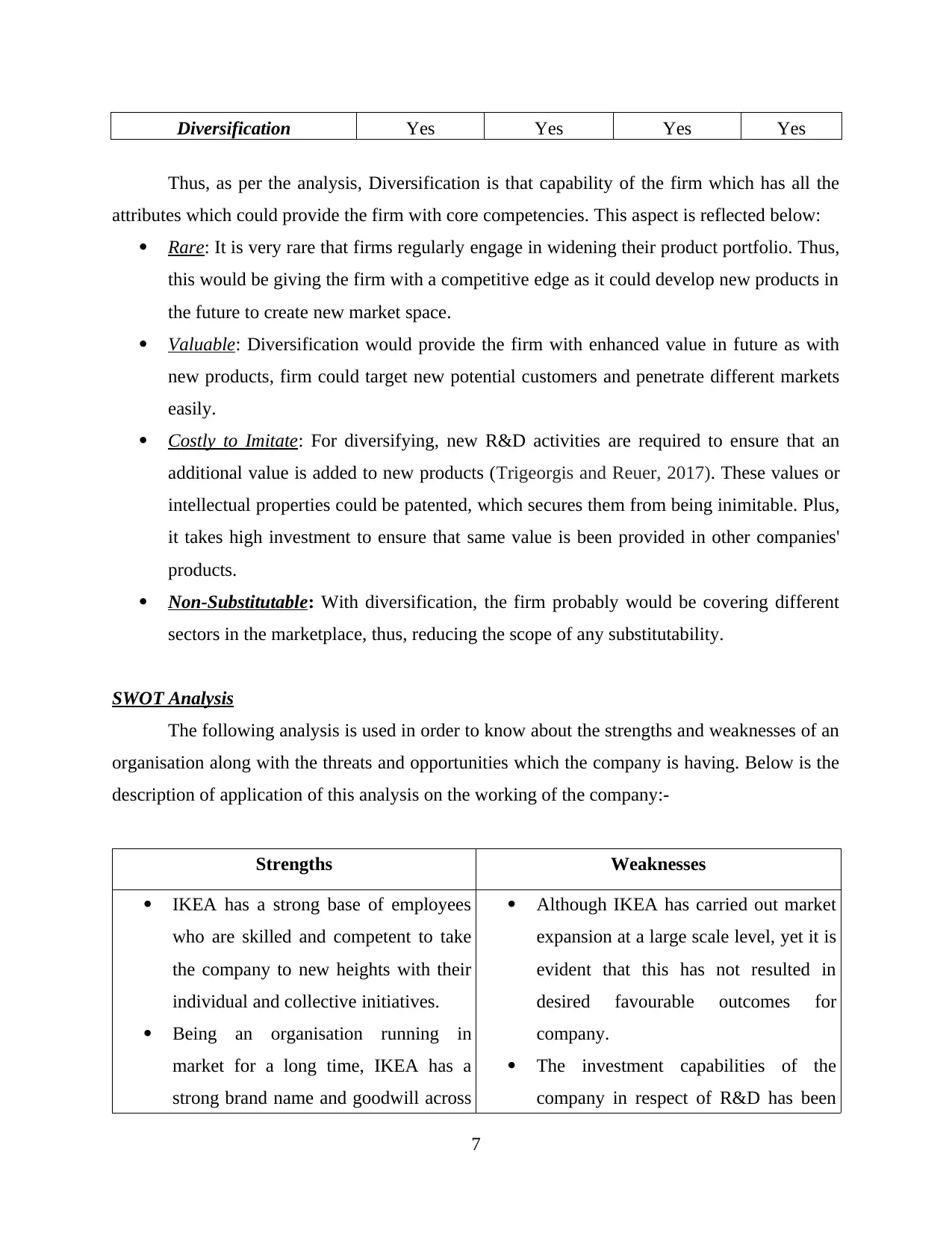
Diversification Yes Yes Yes Yes
Thus, as per the analysis, Diversification is that capability of the firm which has all the
attributes which could provide the firm with core competencies. This aspect is reflected below:
Rare: It is very rare that firms regularly engage in widening their product portfolio. Thus,
this would be giving the firm with a competitive edge as it could develop new products in
the future to create new market space.
Valuable: Diversification would provide the firm with enhanced value in future as with
new products, firm could target new potential customers and penetrate different markets
easily.
Costly to Imitate: For diversifying, new R&D activities are required to ensure that an
additional value is added to new products (Trigeorgis and Reuer, 2017). These values or
intellectual properties could be patented, which secures them from being inimitable. Plus,
it takes high investment to ensure that same value is been provided in other companies'
products.
Non-Substitutable: With diversification, the firm probably would be covering different
sectors in the marketplace, thus, reducing the scope of any substitutability.
SWOT Analysis
The following analysis is used in order to know about the strengths and weaknesses of an
organisation along with the threats and opportunities which the company is having. Below is the
description of application of this analysis on the working of the company:-
Strengths Weaknesses
IKEA has a strong base of employees
who are skilled and competent to take
the company to new heights with their
individual and collective initiatives.
Being an organisation running in
market for a long time, IKEA has a
strong brand name and goodwill across
Although IKEA has carried out market
expansion at a large scale level, yet it is
evident that this has not resulted in
desired favourable outcomes for
company.
The investment capabilities of the
company in respect of R&D has been
7
Thus, as per the analysis, Diversification is that capability of the firm which has all the
attributes which could provide the firm with core competencies. This aspect is reflected below:
Rare: It is very rare that firms regularly engage in widening their product portfolio. Thus,
this would be giving the firm with a competitive edge as it could develop new products in
the future to create new market space.
Valuable: Diversification would provide the firm with enhanced value in future as with
new products, firm could target new potential customers and penetrate different markets
easily.
Costly to Imitate: For diversifying, new R&D activities are required to ensure that an
additional value is added to new products (Trigeorgis and Reuer, 2017). These values or
intellectual properties could be patented, which secures them from being inimitable. Plus,
it takes high investment to ensure that same value is been provided in other companies'
products.
Non-Substitutable: With diversification, the firm probably would be covering different
sectors in the marketplace, thus, reducing the scope of any substitutability.
SWOT Analysis
The following analysis is used in order to know about the strengths and weaknesses of an
organisation along with the threats and opportunities which the company is having. Below is the
description of application of this analysis on the working of the company:-
Strengths Weaknesses
IKEA has a strong base of employees
who are skilled and competent to take
the company to new heights with their
individual and collective initiatives.
Being an organisation running in
market for a long time, IKEA has a
strong brand name and goodwill across
Although IKEA has carried out market
expansion at a large scale level, yet it is
evident that this has not resulted in
desired favourable outcomes for
company.
The investment capabilities of the
company in respect of R&D has been
7
Paraphrase This Document
Need a fresh take? Get an instant paraphrase of this document with our AI Paraphraser

the global periphery.
This entity constantly invests in
technology to gain the attention of large
number of people .
IKEA possess adequate financial
resources owing to which it comes up
with new products at regular intervals
of time.
This corporation has an excellent
supply chain management system with
the help of which it feasibly reach the
customers in due time (Ansoff and et.
al., 2018).
IKEA possess the resources as well as
the capabilities with the help of which
it has always diversified its offerings
within the market.
lacking for years.
Opportunities Threat
Stable political environment presents
opportunities the growth of IKEA.
New Technological Advancements like
Artificial Intelligence and Automation
exposes the firm with opportunities of
enhancing product quality and market
research.
Favourable economical condition of the
country would contribute in better
investment opportunities for IKEA.
The trends within the country change
periodically, making it difficult for the
firm to anticipate demands accurately
and develop products accordingly.
8
This entity constantly invests in
technology to gain the attention of large
number of people .
IKEA possess adequate financial
resources owing to which it comes up
with new products at regular intervals
of time.
This corporation has an excellent
supply chain management system with
the help of which it feasibly reach the
customers in due time (Ansoff and et.
al., 2018).
IKEA possess the resources as well as
the capabilities with the help of which
it has always diversified its offerings
within the market.
lacking for years.
Opportunities Threat
Stable political environment presents
opportunities the growth of IKEA.
New Technological Advancements like
Artificial Intelligence and Automation
exposes the firm with opportunities of
enhancing product quality and market
research.
Favourable economical condition of the
country would contribute in better
investment opportunities for IKEA.
The trends within the country change
periodically, making it difficult for the
firm to anticipate demands accurately
and develop products accordingly.
8
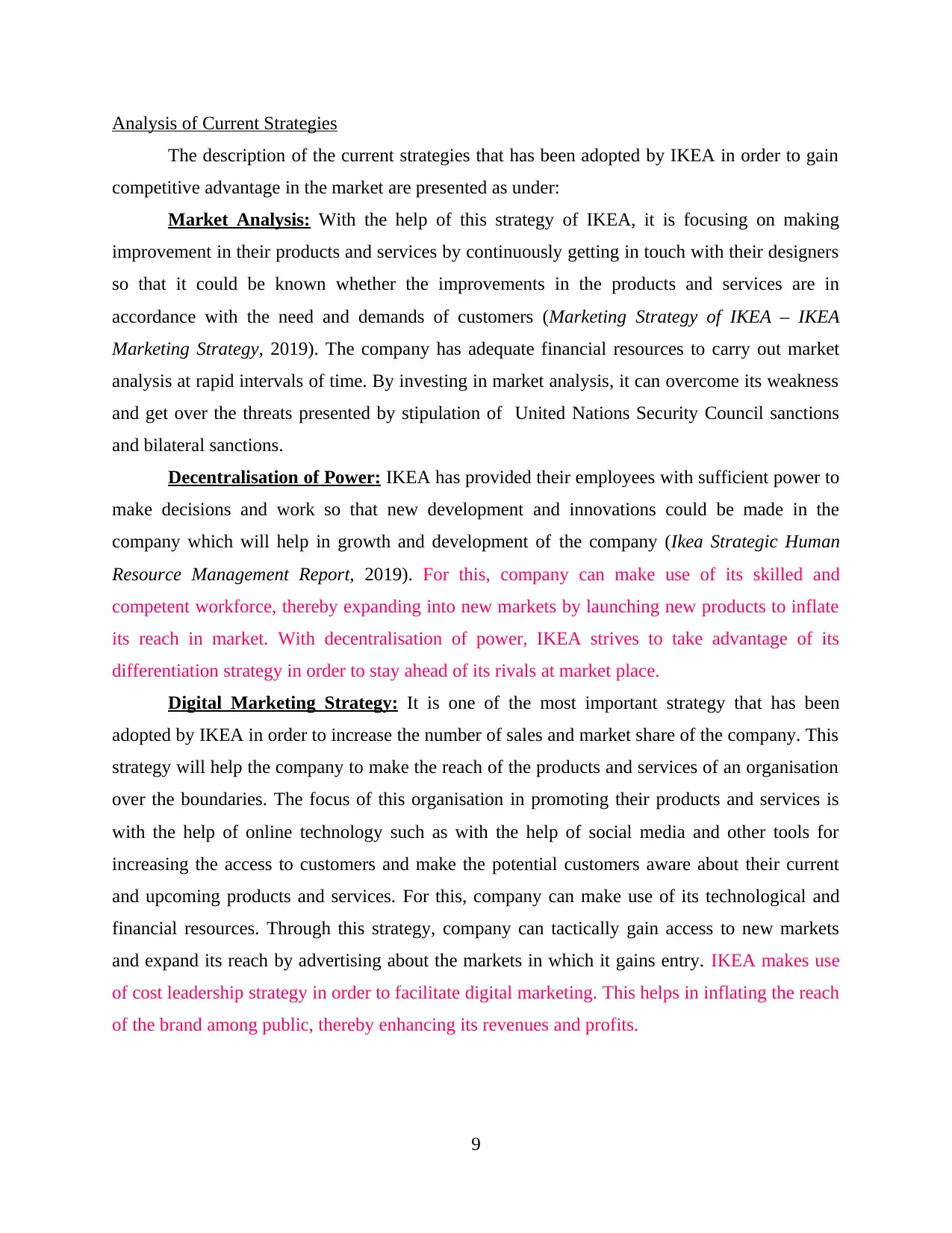
Analysis of Current Strategies
The description of the current strategies that has been adopted by IKEA in order to gain
competitive advantage in the market are presented as under:
Market Analysis: With the help of this strategy of IKEA, it is focusing on making
improvement in their products and services by continuously getting in touch with their designers
so that it could be known whether the improvements in the products and services are in
accordance with the need and demands of customers (Marketing Strategy of IKEA – IKEA
Marketing Strategy, 2019). The company has adequate financial resources to carry out market
analysis at rapid intervals of time. By investing in market analysis, it can overcome its weakness
and get over the threats presented by stipulation of United Nations Security Council sanctions
and bilateral sanctions.
Decentralisation of Power: IKEA has provided their employees with sufficient power to
make decisions and work so that new development and innovations could be made in the
company which will help in growth and development of the company (Ikea Strategic Human
Resource Management Report, 2019). For this, company can make use of its skilled and
competent workforce, thereby expanding into new markets by launching new products to inflate
its reach in market. With decentralisation of power, IKEA strives to take advantage of its
differentiation strategy in order to stay ahead of its rivals at market place.
Digital Marketing Strategy: It is one of the most important strategy that has been
adopted by IKEA in order to increase the number of sales and market share of the company. This
strategy will help the company to make the reach of the products and services of an organisation
over the boundaries. The focus of this organisation in promoting their products and services is
with the help of online technology such as with the help of social media and other tools for
increasing the access to customers and make the potential customers aware about their current
and upcoming products and services. For this, company can make use of its technological and
financial resources. Through this strategy, company can tactically gain access to new markets
and expand its reach by advertising about the markets in which it gains entry. IKEA makes use
of cost leadership strategy in order to facilitate digital marketing. This helps in inflating the reach
of the brand among public, thereby enhancing its revenues and profits.
9
The description of the current strategies that has been adopted by IKEA in order to gain
competitive advantage in the market are presented as under:
Market Analysis: With the help of this strategy of IKEA, it is focusing on making
improvement in their products and services by continuously getting in touch with their designers
so that it could be known whether the improvements in the products and services are in
accordance with the need and demands of customers (Marketing Strategy of IKEA – IKEA
Marketing Strategy, 2019). The company has adequate financial resources to carry out market
analysis at rapid intervals of time. By investing in market analysis, it can overcome its weakness
and get over the threats presented by stipulation of United Nations Security Council sanctions
and bilateral sanctions.
Decentralisation of Power: IKEA has provided their employees with sufficient power to
make decisions and work so that new development and innovations could be made in the
company which will help in growth and development of the company (Ikea Strategic Human
Resource Management Report, 2019). For this, company can make use of its skilled and
competent workforce, thereby expanding into new markets by launching new products to inflate
its reach in market. With decentralisation of power, IKEA strives to take advantage of its
differentiation strategy in order to stay ahead of its rivals at market place.
Digital Marketing Strategy: It is one of the most important strategy that has been
adopted by IKEA in order to increase the number of sales and market share of the company. This
strategy will help the company to make the reach of the products and services of an organisation
over the boundaries. The focus of this organisation in promoting their products and services is
with the help of online technology such as with the help of social media and other tools for
increasing the access to customers and make the potential customers aware about their current
and upcoming products and services. For this, company can make use of its technological and
financial resources. Through this strategy, company can tactically gain access to new markets
and expand its reach by advertising about the markets in which it gains entry. IKEA makes use
of cost leadership strategy in order to facilitate digital marketing. This helps in inflating the reach
of the brand among public, thereby enhancing its revenues and profits.
9
⊘ This is a preview!⊘
Do you want full access?
Subscribe today to unlock all pages.

Trusted by 1+ million students worldwide
1 out of 14
Related Documents
Your All-in-One AI-Powered Toolkit for Academic Success.
+13062052269
info@desklib.com
Available 24*7 on WhatsApp / Email
![[object Object]](/_next/static/media/star-bottom.7253800d.svg)
Unlock your academic potential
Copyright © 2020–2025 A2Z Services. All Rights Reserved. Developed and managed by ZUCOL.





